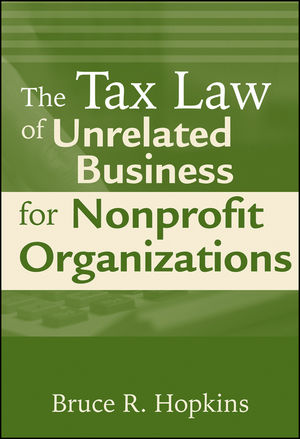The Tax Law of Unrelated Business for Nonprofit OrganizationsISBN: 978-0-470-50084-2
Paperback
408 pages
August 2009
 This is a Print-on-Demand title. It will be printed specifically to fill your order. Please allow an additional 10-15 days delivery time. The book is not returnable.
|
||||||
Chapter One: Tax Exemption and Unrelated Business: Introduction.
1.1 Tax Exemption: A Perspective.
1.2 Source of Tax Exemption.
1.3 Tax-Exempt Organizations.
1.4 Philosophical Principles of Exempt Organizations Law.
1.5 Categories of Tax-Exempt Organizations.
1.6 Rationale for Unrelated Business Rules.
1.7 Organizations Subject to Unrelated Business Rules.
1.8 Tax Exemption and Competition.
1.9 Concise History of the Unrelated Business Rules.
1.10 Private Inurement and Private Benefit.
1.11 Determining Allowable Unrelated Business.
Chapter Two: Unrelated Business: The Basics.
2.1 The Analytic Framework.
2.2 Definition of Trade or Business.
2.3 Fragmentation Rule.
2.4 Profit Motive Requirement.
2.5 Definition of Regularly Carried On.
2.6 Definition of Related Business.
2.7 Definition of Substantially Related Business.
Chapter Three: Modifications.
3.1 Passive Income in General.
3.2 Dividends.
3.3 Interest.
3.4 Securities Lending Income.
3.5 Certain Consideration.
3.6 Annuities.
3.7 Royalties.
3.8 Rent.
3.9 Other Investment Income.
3.10 Capital Gains.
3.11 Gain from Lapses or Terminations of Options.
3.12 Loan Commitment Fees.
3.13 Research Income.
3.14 Electric Companies’ Member Income.
3.15 Foreign Source Income.
3.16 Brownfield Sites Gains.
3.17 Religious Order Rule.
3.18 Charitable Deduction.
3.19 Specific Deduction.
3.20 Net Operating Losses.
Chapter Four: Exceptions.
4.1 Convenience Businesses.
4.2 Businesses Conducted by Volunteers.
4.4 Entertainment Activities.
4.5 Trade Shows.
4.6 Hospital Services.
4.7 Gambling Activities.
4.8 Associate Member Dues.
4.9 Low-Cost Articles.
4.10 Mailing Lists.
4.11 Businesses of Employees’ Associations.
4.12 S Corporation Holdings and Sales.
4.13 Pole Rental Activities.
Chapter Five: Unrelated Debt-Financed Income Rules.
5.1 History and Overview of Rules.
5.2 Unrelated Debt-Financed Income.
5.3 Debt-Financed Property.
5.4 Acquisition Indebtedness.
5.5 Computation of Unrelated Debt-Financed Income.
Chapter Six: Special Rules.
6.1 Rules for Social Clubs.
6.2 Rules for Certain Other Tax-Exempt Organizations.
6.3 Private Foundation Rules.
6.4 Partnership Rules.
6.5 Advertising.
6.6 Corporate Sponsorships.
Chapter Seven: Commercial Activities.
7.1 Commerciality Doctrine: Origins.
7.2 Contemporary Perspective on Doctrine.
7.3 Commercial-Type Insurance Rules.
7.4 Credit Counseling Organizations.
7.5 Social Enterprise Movement.
7.6 Commerciality and Unrelated Business Rules.
Chapter Eight: Use of Separate Entities.
8.1 Necessity of Separate Entity.
8.2 Choice of Form.
8.3 Element of Control.
8.4 Attribution Considerations.
8.5 Capitalization.
8.6 Sharing of Resources.
8.7 Liquidations.
8.8 Controlled Organizations.
8.9 Partnerships and Joint Venture Basics.
8.10 Flow-Through Entities.
8.11. Partnerships—Details.
8.12 Limited Liability Companies—Details.
8.13 Other Joint Ventures.
8.14 Whole Entity Joint Ventures.
8.15 Ancillary Joint Ventures.
8.16 Law-Imposed Joint Ventures.
8.17 Look-Through Rule—Details.
Chapter Nine: Contemporary Applications of the Unrelated Business Rules.
9.1 Educational Institutions.
9.2 Health Care Providers.
9.3 Museums.
9.4 Associations.
9.5 Labor and Agricultural Organizations.
9.6 Fundraising Activities.
9.7 Travel Opportunities.
9.8 Provision of Services.
9.9 Sharecrop Leasing.
9.10 Retirement Plan Reversions.
9.11 Exempt Functions as Unrelated Business.
9.12 Other Instances of Related Business.
9.13 Other Instances of Unrelated Business.
9.14 Agency Rule.
Chapter Ten: Unrelated Business and the Internet.
10.1 State of the “Law”.
10.2 Two Overarching Issues.
10.3 Web-Based Business: Tax Law Perspective.
10.4 Web Site Advertising.
10.5 Web Site Corporate Sponsorships.
10.6 Trade Shows.
10.7 Merchandising.
10.8 Auctions.
10.9 Charity Malls.
10.10 Merchant Affiliate Programs.
10.11 Associations.
10.12 Web Site Material as Periodical.
10.13 Royalty Arrangements.
10.14 Questions Posed by IRS Announcement.
10.15 Summary.
Chapter Eleven: Reporting Requirements.
11.1 Tax Structure.
11.2 Deduction Rules.
11.3 Annual Information Return.
11.4 Unrelated Business Income Tax Return.
11.5 Other Rules Concerning Preparation and Filing of Return.
Appendices.
Appendix A: Sources of the Law.
Appendix B: Internal Revenue Code Sections.
Appendix C: Glossary.
Appendix D: Form 990.
Appendix E: Form 990 T.
Appendix F: Codes for Unrelated Business Activity.
Tables.
Table of Cases.
Table of IRS Revenue Rulings and Revenue Procedures.
Table of IRS Private Determinations Cited in Text.
Table of Related IRS Private Determinations.
Table of Cases Discussed in Bruce R. Hopkins’ Nonprofit Counsel.
Table of IRS Private Determinations Discussed in Bruce R. Hopkins’ Nonprofit Counsel.
Index.



